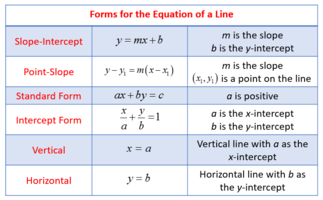You are using an out of date browser. It may not display this or other websites correctly.
You should upgrade or use an alternative browser.
You should upgrade or use an alternative browser.
Linear equation ax+b=c: why 3 constraints? why not 2 or 4?
- Thread starter Asam
- Start date
Dr.Peterson
Elite Member
- Joined
- Nov 12, 2017
- Messages
- 16,089
How would you represent such an equation with 2 or 4 constants? Show us, and we will have more to discuss.View attachment 35346Hello, everyone
why in general form of linear equation we have 3 constants. Why not 2 or 4?
Thank you!
My standard answer when someone asks "Why can't we do it this other way?" is "Try it and see. You may find why; or you may find it doesn't matter."
Steven G
Elite Member
- Joined
- Dec 30, 2014
- Messages
- 14,383
If in fact ax+b=c is the general form of a linear equation then there are three constants because there are three constants--namely, a, b and c.View attachment 35346Hello, everyone
why in general form of linear equation we have 3 constants. Why not 2 or 4?
Thank you!
View attachment 35346Hello, everyone
why in general form of linear equation we have 3 constants.
Asam, please check your source. It should be \(\displaystyle \ ax + by = c, \ \) as in I expected you copied it incorrectly.
Harry_the_cat
Elite Member
- Joined
- Mar 16, 2016
- Messages
- 3,693
ax +by = c is the general form of a linear function.Asam, please check your source. It should be \(\displaystyle \ ax + by = c, \ \) as in I expected you copied it incorrectly.
ax + b is the general form of a linear expression.
ax + b = c, eg 3x + 5 = 11, is the general form of a linear equation, which of course can be quickly changed into 3x - 6 = 0 (which still has 3 constants ie 3, -6 and 0).
Still has 3 constants, namely a, d and 0.Where did you find 3 constants? I thought a general form is [imath]ax+d=0[/imath], which you would get by using [imath]d=b-c[/imath].
Otis
Elite Member
- Joined
- Apr 22, 2015
- Messages
- 4,414
I learned (albeit decades ago) that all general forms have zero on one side, whereas standard forms have the variable terms or the constant separated. Since then, I've seen the names 'General' and 'Standard' defined in so many different ways that I try to accept whatever name the other person uses. Times have changed. Either of the following two forms might be called 'general' or 'standard'.
Ax + By + C = 0
Ax + By = C
I regularly see each of the following called 'standard', too.
y = mx + b
y - y1 = m(x - x1)
When I first read the op, I'd wondered why they had y=c, heh.

[imath]\;[/imath]
Ax + By + C = 0
Ax + By = C
I regularly see each of the following called 'standard', too.
y = mx + b
y - y1 = m(x - x1)
When I first read the op, I'd wondered why they had y=c, heh.

[imath]\;[/imath]
Last edited:
Dr.Peterson
Elite Member
- Joined
- Nov 12, 2017
- Messages
- 16,089
The main question here is, what does the OP mean by "general form", and (perhaps even more important) by "linear equation"? That's why I started with a question, and really can't say any more until we get that answer. My initial assumption would be that the form shown is what was taught, and therefore it determines what they must mean by "linear equation".
If he means a linear equation in one variable, then none of what has been said about equations of lines is relevant. But also, there are a couple different forms that could be called "general" (which happen to have 2 and 4 constants, interestingly enough), and if the form shown is what he was taught, then the ultimate answer is, "That's what some author chose to call the general form, but it is not the only choice".
In my experience, one of the least standardized words in mathematics is "standard"; and one of the least generally agreed upon words is "general". All definitions of these words are ultimately arbitrary, and I am not surprised if someone uses them differently than I might have learned, or might prefer if I were writing a book.
If he means a linear equation in one variable, then none of what has been said about equations of lines is relevant. But also, there are a couple different forms that could be called "general" (which happen to have 2 and 4 constants, interestingly enough), and if the form shown is what he was taught, then the ultimate answer is, "That's what some author chose to call the general form, but it is not the only choice".
In my experience, one of the least standardized words in mathematics is "standard"; and one of the least generally agreed upon words is "general". All definitions of these words are ultimately arbitrary, and I am not surprised if someone uses them differently than I might have learned, or might prefer if I were writing a book.

